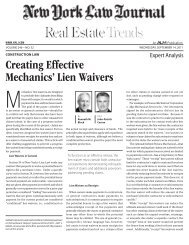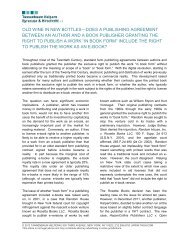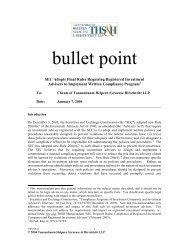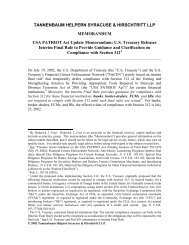Applying "no-contact rule" and replying to all in email communications
Applying "no-contact rule" and replying to all in email communications
Applying "no-contact rule" and replying to all in email communications
Create successful ePaper yourself
Turn your PDF publications into a flip-book with our unique Google optimized e-Paper software.
such as “Senior Vice President <strong>and</strong><br />
General Counsel”) presumptively<br />
signify that the person acts as lawyer<br />
for the organization, unless<br />
there is <strong>no</strong>tice <strong>to</strong> the contrary.<br />
By contrast, other titles, such as<br />
“Direc<strong>to</strong>r of Legal <strong>and</strong> Corporate<br />
Affairs” or “Direc<strong>to</strong>r of Compliance”<br />
are ambiguous as <strong>to</strong> the role<br />
performed by the titleholder <strong>in</strong> a<br />
particular matter, <strong>and</strong> would <strong>no</strong>t,<br />
st<strong>and</strong><strong>in</strong>g alone, give rise <strong>to</strong> the<br />
same presumption.<br />
(2) Court papers. If the matter <strong>in</strong><br />
question is a litigation, papers filed<br />
<strong>in</strong> the case may list the <strong>in</strong>-house<br />
counsel as “Of Counsel.” Such a<br />
reference would reasonably entitle<br />
a<strong>no</strong>ther lawyer <strong>in</strong> the case <strong>to</strong><br />
assume that the listed person is<br />
act<strong>in</strong>g as a lawyer.<br />
(3) Course of conduct. In both litigation<br />
<strong>and</strong> transactional matters,<br />
the course of conduct between the<br />
<strong>in</strong>-house counsel <strong>and</strong> the lawyer<br />
who wishes <strong>to</strong> <strong>contact</strong> him or her<br />
may give rise <strong>to</strong> the reasonable<br />
presumption that <strong>in</strong>-house counsel<br />
is act<strong>in</strong>g as a lawyer. Course of<br />
conduct may also <strong>in</strong>clude prior,<br />
related, or similar proceed<strong>in</strong>gs; if<br />
<strong>in</strong>-house counsel actively represented<br />
the organization <strong>in</strong> such a<br />
proceed<strong>in</strong>g, one could fairly presume<br />
that he or she is fulfill<strong>in</strong>g the<br />
same role <strong>in</strong> the current proceed<strong>in</strong>g<br />
as well.<br />
(4) Membership <strong>in</strong> an <strong>in</strong>-house<br />
legal department. Corporations<br />
often ma<strong>in</strong>ta<strong>in</strong> a legal department<br />
whose at<strong>to</strong>rneys serve the needs<br />
of the bus<strong>in</strong>ess from a centralized<br />
location. In those <strong>in</strong>stances, the<br />
similarity of the <strong>in</strong>-house lawyer’s<br />
role <strong>to</strong> that of a member of an outside<br />
law firm is most pro<strong>no</strong>unced,<br />
<strong>and</strong> ord<strong>in</strong>arily would <strong>in</strong>dicate that<br />
the members of the department are<br />
serv<strong>in</strong>g the entity as lawyers.<br />
(5) Inquiry. A lawyer who wishes<br />
<strong>to</strong> communicate with <strong>in</strong>-house<br />
counsel of a<strong>no</strong>ther party can ask<br />
the <strong>in</strong>-house counsel if he or she<br />
is act<strong>in</strong>g as at<strong>to</strong>rney for the organization.<br />
In-house counsel should<br />
exercise c<strong>and</strong>or <strong>in</strong> clarify<strong>in</strong>g their<br />
role <strong>to</strong> oppos<strong>in</strong>g counsel <strong>and</strong> a<br />
lawyer who makes such <strong>in</strong>quiry<br />
can ord<strong>in</strong>arily rely on the response.<br />
Id. (<strong>in</strong>ternal citations omitted).<br />
More likely than <strong>no</strong>t, the VPMS<br />
wore his “bus<strong>in</strong>ess person” hat <strong>and</strong><br />
would <strong>no</strong>t meet the stated objective<br />
<strong>in</strong>dicia which the Committee proposed<br />
<strong>in</strong> N.Y. City 2007-1, <strong>all</strong>ow<strong>in</strong>g you <strong>to</strong><br />
directly communicate with him. Moreover,<br />
s<strong>in</strong>ce he was previously deposed<br />
as a “fact” witness, Rule 3.7(a) may<br />
provide some guidance. It states that<br />
“[a] lawyer sh<strong>all</strong> <strong>no</strong>t act as advocate<br />
before a tribunal <strong>in</strong> a matter <strong>in</strong> which<br />
the lawyer is likely <strong>to</strong> be a witness on<br />
a significant issue of fact . . .” except<br />
under certa<strong>in</strong> circumstances. Therefore,<br />
under Rule 3.7(a), it appears that<br />
the VPMS would <strong>no</strong>t be act<strong>in</strong>g as a<br />
“lawyer” <strong>in</strong> this scenario, <strong>and</strong> you<br />
would <strong>no</strong>t be able <strong>to</strong> directly communicate<br />
with him.<br />
With regard <strong>to</strong> your question concern<strong>in</strong>g<br />
communicat<strong>in</strong>g settlement<br />
offers, it would be <strong>in</strong>appropriate for<br />
you <strong>to</strong> go around your adversary <strong>and</strong><br />
communicate a settlement offer <strong>to</strong> an<br />
oppos<strong>in</strong>g party “absent the other lawyer’s<br />
consent or specific legal authority<br />
<strong>to</strong> do so.” N.Y. City Bar Op. 2009-1<br />
(2009) (cit<strong>in</strong>g ABA Formal Op. 92-362).<br />
Even if the VPMS c<strong>all</strong>s you on his<br />
own after the deposition <strong>to</strong> discuss<br />
the settlement offer you had previously<br />
communicated, the best practice<br />
would be <strong>to</strong> advise him that s<strong>in</strong>ce his<br />
employer is represented by counsel,<br />
<strong>all</strong> <strong>communications</strong> should go through<br />
the organization’s outside counsel.<br />
In response <strong>to</strong> your <strong>in</strong>quiry whether<br />
you may advise your client <strong>to</strong> directly<br />
communicate with the pla<strong>in</strong>tiff-company<br />
regard<strong>in</strong>g settlement, Rule 4.2(b)<br />
states that “[n]otwithst<strong>and</strong><strong>in</strong>g the prohibitions<br />
of paragraph (a) [of Rule<br />
4.2], <strong>and</strong> unless otherwise prohibited<br />
by law, a lawyer may cause a client<br />
<strong>to</strong> communicate with a represented<br />
person unless the represented person<br />
is <strong>no</strong>t leg<strong>all</strong>y competent <strong>and</strong> may counsel<br />
the client with respect <strong>to</strong> those<br />
<strong>communications</strong>, provided the lawyer<br />
gives reasonable advance <strong>no</strong>tice <strong>to</strong> the<br />
represented person’s counsel that such<br />
<strong>communications</strong> will be tak<strong>in</strong>g place.”<br />
Comment [11] <strong>to</strong> Rule 4.2 states that<br />
“[p]ersons represented <strong>in</strong> a matter may<br />
communicate directly with each other”<br />
<strong>and</strong> that “[a] lawyer may properly<br />
advise a client <strong>to</strong> communicate directly<br />
with a represented person, <strong>and</strong> may<br />
counsel the client with respect <strong>to</strong> those<br />
<strong>communications</strong>, provided the lawyer<br />
complies with paragraph (b) [of Rule<br />
4.2].” Although direct <strong>communications</strong><br />
between the clients are permitted by<br />
the rule, a lawyer can<strong>no</strong>t counsel a<br />
client <strong>to</strong> have direct <strong>communications</strong><br />
with the oppos<strong>in</strong>g party unless the<br />
lawyer first gives reasonable advance<br />
<strong>no</strong>tice <strong>to</strong> oppos<strong>in</strong>g counsel. This <strong>no</strong>tice<br />
should always be given <strong>in</strong> writ<strong>in</strong>g or<br />
confirmed <strong>in</strong> writ<strong>in</strong>g if the <strong>no</strong>tice is<br />
given or<strong>all</strong>y. See Roy Simon, Simon’s<br />
New York Rules of Professional Conduct<br />
An<strong>no</strong>tated at 845 (2012 ed.). The<br />
advance <strong>no</strong>tice pro<strong>to</strong>col conta<strong>in</strong>ed <strong>in</strong><br />
the Rule is <strong>no</strong>t a request for consent<br />
or an <strong>in</strong>vitation for an objection so<br />
you may proceed once you have given<br />
advance <strong>no</strong>tice, even if your adversary<br />
should voice an objection.<br />
It is unfortunately a sad reality that<br />
from time <strong>to</strong> time we encounter adversaries<br />
who act <strong>in</strong> a manner which<br />
may prevent the resolution of a case<br />
that should ultimately be settled. Some<br />
have suggested that if an at<strong>to</strong>rney<br />
believes his adversary is <strong>no</strong>t communicat<strong>in</strong>g<br />
offers of settlement <strong>to</strong> his client,<br />
then the at<strong>to</strong>rney may request a settlement<br />
conference before the court with<br />
the client required <strong>to</strong> be at the conference,<br />
so that a settlement offer may be<br />
openly discussed before a judge. See<br />
Simon at 828.<br />
Turn<strong>in</strong>g <strong>to</strong> your next question<br />
regard<strong>in</strong>g <strong>email</strong> <strong>communications</strong>, the<br />
use of the “reply <strong>all</strong>” but<strong>to</strong>n is a convenient<br />
way of communicat<strong>in</strong>g with<br />
multiple parties but at times can be<br />
problematic, especi<strong>all</strong>y when at<strong>to</strong>rneys<br />
“cc” their clients on an <strong>email</strong> <strong>to</strong> oppos<strong>in</strong>g<br />
counsel. The h<strong>and</strong>ful of ethics op<strong>in</strong>ions<br />
that specific<strong>all</strong>y discuss “reply <strong>all</strong>”<br />
<strong>email</strong>s <strong>in</strong> the context of the “<strong>no</strong>-<strong>contact</strong><br />
rule” offer <strong>no</strong> clear-cut answer. While<br />
the op<strong>in</strong>ions suggest that there may<br />
be situations where consent may be<br />
implied, the best practice is <strong>to</strong> avoid the<br />
m<strong>in</strong>efield by resist<strong>in</strong>g the temptation<br />
NYSBA Journal | September 2012 | 47






